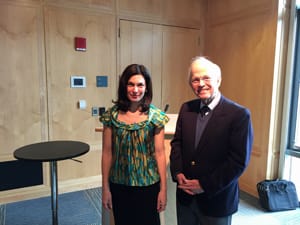November 18, 2015
Iran’s Reform Movement
Laura Secor
Freelance writer; Visiting Professor of Journalism, Princeton
Iran’s Reform Movement
Laura Secor
Freelance writer; Visiting Professor of Journalism, Princeton
Minutes of the Tenth Meeting of the 74th Year
President Owen G. Leach called the meeting to order at 10.15 a.m. The attendance was 156. Two guests were introduced. Landon Jones introduced the speaker, Laura Secor, freelance writer and visiting
professor of journalism at Princeton University. Her topic was Iran's Reform Movement, the subject of her book soon to be published. The talk was a valuable summary of would-be reformers in Iran, a subject few of us know anything about.
Secor explained that she first visited Iran in 2004 out of a somewhat perverse interest as few United States citizens had gone there since the fall of the Shah in 1979. She knew American-Iranian relations were unsettling, but regarded Iran as important because of its nuclear ambitions, its hostility towards America, and its rich oil reserves. She asserted that Iran was unknowable, like a black box she wanted to penetrate. She saw Iran as a land of conflicting images: one, a land of hostage takers, anti-American mobs, fanaticism, and promoter of Shiism; the other, hip and sophisticated with liberal-minded youngsters. Iran was divided politically and culturally in the past and in the present.
Her primary interest was in Iranians from religious backgrounds who wanted reforms. She met a number of former revolutionaries who were formerly optimistic but now disillusioned. She praised one theologian, Ali Shariati who tried to bring leftists and believers in Islam together. He believed in a classless society and an end to imperialism. She said he had reinvented militant Shiism. She also argued that Ayatollah Khomeini when he came to power had accepted some of Shariati's ideas though he had set up a theocratic state.
Secor's overall point was that Iran was experiencing constitutional combat between Muslim reformers and extremist clerics. Iran has elected officials, but also clerical bodies that can override them on all issues. The system was part popular, part divine. She asserted that liberal factions still remained though they were weak in comparison with clerics who controlled the means of suppression, censored everything and forced
confessions from people arrested. She thought there was substantial cheating at elections.
Secor ended by expressing disappointment at the repression she was aware of in her last visits to the country. At the same time, she argued that President Rouhani had brought back the liberal middle class into the system. Iran continues to be divided.
Respectfully submitted,
Michael Curtis
professor of journalism at Princeton University. Her topic was Iran's Reform Movement, the subject of her book soon to be published. The talk was a valuable summary of would-be reformers in Iran, a subject few of us know anything about.
Secor explained that she first visited Iran in 2004 out of a somewhat perverse interest as few United States citizens had gone there since the fall of the Shah in 1979. She knew American-Iranian relations were unsettling, but regarded Iran as important because of its nuclear ambitions, its hostility towards America, and its rich oil reserves. She asserted that Iran was unknowable, like a black box she wanted to penetrate. She saw Iran as a land of conflicting images: one, a land of hostage takers, anti-American mobs, fanaticism, and promoter of Shiism; the other, hip and sophisticated with liberal-minded youngsters. Iran was divided politically and culturally in the past and in the present.
Her primary interest was in Iranians from religious backgrounds who wanted reforms. She met a number of former revolutionaries who were formerly optimistic but now disillusioned. She praised one theologian, Ali Shariati who tried to bring leftists and believers in Islam together. He believed in a classless society and an end to imperialism. She said he had reinvented militant Shiism. She also argued that Ayatollah Khomeini when he came to power had accepted some of Shariati's ideas though he had set up a theocratic state.
Secor's overall point was that Iran was experiencing constitutional combat between Muslim reformers and extremist clerics. Iran has elected officials, but also clerical bodies that can override them on all issues. The system was part popular, part divine. She asserted that liberal factions still remained though they were weak in comparison with clerics who controlled the means of suppression, censored everything and forced
confessions from people arrested. She thought there was substantial cheating at elections.
Secor ended by expressing disappointment at the repression she was aware of in her last visits to the country. At the same time, she argued that President Rouhani had brought back the liberal middle class into the system. Iran continues to be divided.
Respectfully submitted,
Michael Curtis

